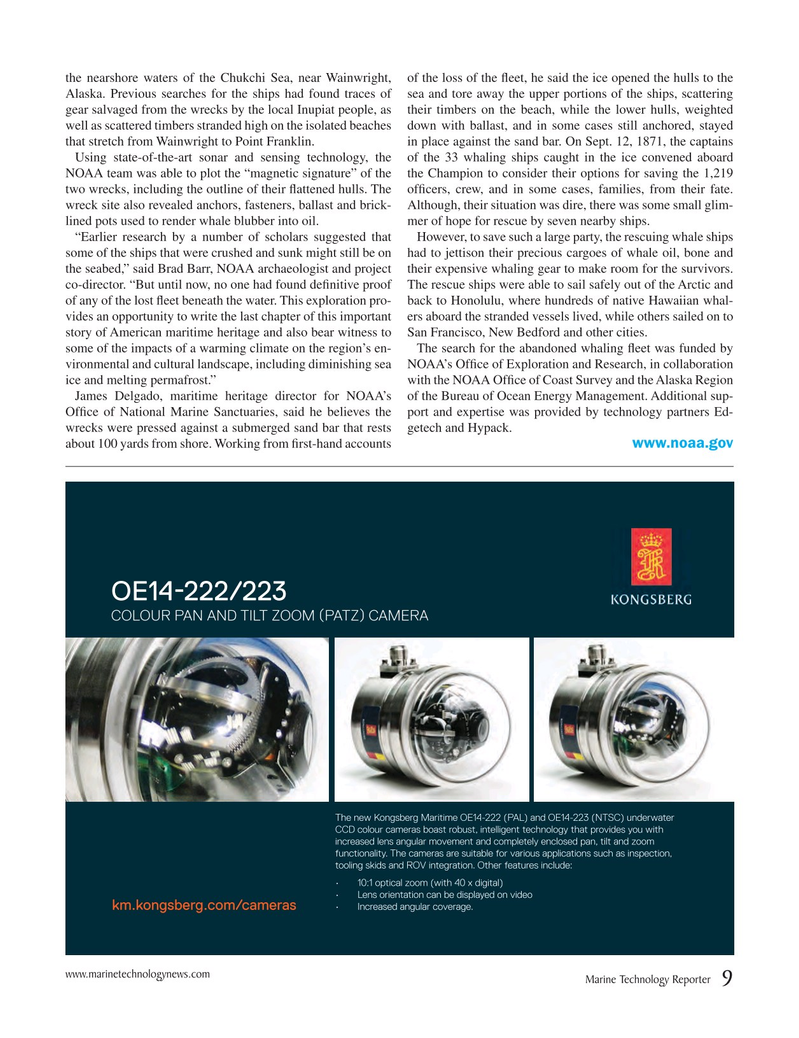
Page 9: of Marine Technology Magazine (January 2016)
Underwater Vehicle Annual: ROV, AUV, and UUVs
Read this page in Pdf, Flash or Html5 edition of January 2016 Marine Technology Magazine
the nearshore waters of the Chukchi Sea, near Wainwright, of the loss of the ? eet, he said the ice opened the hulls to the
Alaska. Previous searches for the ships had found traces of sea and tore away the upper portions of the ships, scattering gear salvaged from the wrecks by the local Inupiat people, as their timbers on the beach, while the lower hulls, weighted well as scattered timbers stranded high on the isolated beaches down with ballast, and in some cases still anchored, stayed that stretch from Wainwright to Point Franklin. in place against the sand bar. On Sept. 12, 1871, the captains
Using state-of-the-art sonar and sensing technology, the of the 33 whaling ships caught in the ice convened aboard
NOAA team was able to plot the “magnetic signature” of the the Champion to consider their options for saving the 1,219 two wrecks, including the outline of their ? attened hulls. The of? cers, crew, and in some cases, families, from their fate. wreck site also revealed anchors, fasteners, ballast and brick- Although, their situation was dire, there was some small glim- lined pots used to render whale blubber into oil. mer of hope for rescue by seven nearby ships.
“Earlier research by a number of scholars suggested that However, to save such a large party, the rescuing whale ships some of the ships that were crushed and sunk might still be on had to jettison their precious cargoes of whale oil, bone and the seabed,” said Brad Barr, NOAA archaeologist and project their expensive whaling gear to make room for the survivors. co-director. “But until now, no one had found de? nitive proof The rescue ships were able to sail safely out of the Arctic and of any of the lost ? eet beneath the water. This exploration pro- back to Honolulu, where hundreds of native Hawaiian whal- vides an opportunity to write the last chapter of this important ers aboard the stranded vessels lived, while others sailed on to story of American maritime heritage and also bear witness to San Francisco, New Bedford and other cities.
some of the impacts of a warming climate on the region’s en- The search for the abandoned whaling ? eet was funded by vironmental and cultural landscape, including diminishing sea NOAA’s Of? ce of Exploration and Research, in collaboration ice and melting permafrost.” with the NOAA Of? ce of Coast Survey and the Alaska Region
James Delgado, maritime heritage director for NOAA’s of the Bureau of Ocean Energy Management. Additional sup-
Of? ce of National Marine Sanctuaries, said he believes the port and expertise was provided by technology partners Ed- wrecks were pressed against a submerged sand bar that rests getech and Hypack.
about 100 yards from shore. Working from ? rst-hand accounts www.noaa.gov www.marinetechnologynews.com
Marine Technology Reporter 9
MTR #1 (1-17).indd 9 1/21/2016 3:27:21 PM

 8
8

 10
10
